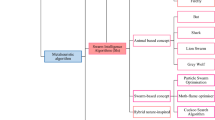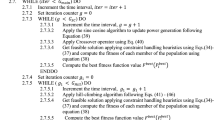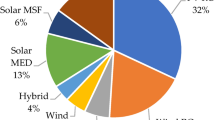Abstract
This paper presents the applications of novel metaheuristic algorithms including equilibrium optimization (EO), coot optimization, and slime mould optimization together with three Particle swarm optimization variants for optimal power generation cooperation of power systems with conventional hydroelectric power plants, thermal power plants and especially pumped-storage hydroelectric plants (PHPs). Three different power systems are applied to run these algorithms to prove that PHPs have a significant contribution to the generation cost reduction. In the first two systems, there are not inflows to the upper reservoirs of the PHPs and these plants only produce electricity by using pumped water. In the third system, inflows to PHPs are considered. The requirement is that the volume of reservoir at the beginning and the end of a day must be the same. However, the generation cost for the cases with the operation of PHPs is much less than other cases without the PHPs or without the pump mode of PHP. About the generation cost of three systems, PHPs support to reach the saving cost of $1,222.1998, $89,091.16, and $94,449.2 corresponding to 0.45%, 3% and 3.4%, respectively. So, the PHPs should be run in power systems. Among the six applied methods, EO is the best since it can reach less cost than others from higher than 2% to under 8%. Hence, it is recommended that EO is a potential method for finding optimal operation parameters of power systems with the PHPs.














Similar content being viewed by others
Abbreviations
- \(PT_{t,k}\) :
-
Generation of the tth TP at the kth period
- \(a_{1t}\), \(a_{2t}\), \(a_{3t}\) :
-
Cost coefficients of the tth TP
- \(N_{1}\) :
-
Number of TPs
- \(N_{2}\) :
-
Number of periods
- \(PT_{t}^{min}\), \(PT_{t}^{max}\) :
-
Minimum and maximum generations of the tth TP
- \(PH_{i,k}\), \(PH_{j,k}^{Gen}\) :
-
Generation of the ith CHP and the jth PHP at the kth period
- \(PL_{k}\) :
-
Power loss of the power system at the kth period
- \(PD_{k}\) :
-
Load at the kth period
- \(N_{3}\), \(N_{4}\) :
-
Number of CHPs and PHPs
- \(PH_{j,k}^{Pum}\), ON pumj,k :
-
Pump power and pump status of the jth PHP at the kth period
- Q j,k and V j,k :
-
Discharge and volume of the jth PHP at the kth period
- \(Q_{j}^{min}\), \(Q_{j}^{max}\) :
-
Lower and upper discharge limits of the jth PHP
- \(V_{j}^{min}\), \(V_{j}^{max}\) :
-
Lower and upper volume limits of the jth PHP
- \(b_{1j}\), \(b_{2j}\), \(b_{3j}\) :
-
Generation function coefficients of the jth PHP
- \(PH_{j}^{Genmin}\), \(PH_{j}^{Genmax}\) :
-
Minimum and maximum generations of the jth PHP
- \(I_{j,k}\), \(S_{j,k}\) :
-
Inflow and spillage of the jth PHP at the kth period
- \(x_{ad}^{new}\) :
-
Newly updated value of the dth control variable in the ath solution
- N D, N M :
-
Number of control and dependent variables.
- x ad , y am :
-
The dth control and the mth dependent variables in the ath solution
- \(x_{d\min } ,x_{d\max }\) :
-
Minimum and maximum limits of the dth control variable
- \(y_{m\min } ,y_{m\max }\) :
-
Minimum and maximum limits of the mth dependent variable
- rnd :
-
Random number within 0 and 1
- N S :
-
Population
- It, It max :
-
Present iteration and maximum iteration.
- \(\Delta Q_{{j,k^{{\prime }} }}\) :
-
Discharge violation of the jth PHP at the k′th period
- \(\Delta V_{j,k}\), \(\Delta V_{i,k}\) :
-
Volume violation of the jth PHP and the ith CHP at the kth period
- \(\Delta Q_{{i,k^{{\prime }} }}\) :
-
Discharge violation of the ith CHP at the k′th period
- \(PT_{1,k}\), \(\Delta PT_{1,k}\) :
-
Generation and generation violation of the first TP at the kth period
- \(PT_{1}^{min} {,} PT_{1}^{max}\) :
-
Minimum and maximum generation of the first TP
References
Homem-De-Mello T, De Matos VL, Finardi EC (2011) Sampling strategies and stopping criteria for stochastic dual dynamic programming: a case study in long-term hydrothermal scheduling. Energy Syst 2:1–31. https://doi.org/10.1007/s12667-011-0024-y
De Matos VL, Finardi EC (2012) A computational study of a stochastic optimization model for long term hydrothermal scheduling. Int J Electr Power Energy Syst 43:1443–1452. https://doi.org/10.1016/j.ijepes.2012.06.021
Beltran F, De Oliveira W, Finardi EC (2017) Application of scenario tree reduction via quadratic process to medium-term hydrothermal scheduling problem. IEEE Trans Power Syst 32:4351–4361. https://doi.org/10.1109/TPWRS.2017.2658444
Cicconet F, Almeida KC (2019) Moment-SOS relaxation of the medium term hydrothermal dispatch problem. Int J Electr Power Energy Syst 104:124–133. https://doi.org/10.1016/j.ijepes.2018.06.004
Nguyen TT, Vo DN, Truong AV (2014) Cuckoo search algorithm for short-term hydrothermal scheduling. Appl Energy 132:276–287. https://doi.org/10.1016/j.apenergy.2014.07.017
Nguyen TT, Vo DN (2015) Modified cuckoo search algorithm for short-term hydrothermal scheduling. Int J Electr Power Energy Syst 65:271–281. https://doi.org/10.1016/j.ijepes.2014.10.004
Basu M (2011) Economic environmental dispatch of fixed head hydrothermal power systems using nondominated sorting genetic algorithm-II. Appl Soft Comput J 11:3046–3055. https://doi.org/10.1016/j.asoc.2010.12.005
Ramesh Kumar B, Murali M, Sailaja Kumari M, Sydulu M (2012) Short-range fixed head hydrothermal scheduling using fast genetic algorithm. In: Proceedings of 2012 7th IEEE conference on industrial electronics and applications ICIEA, 2012, pp 1313–1318. https://doi.org/10.1109/ICIEA.2012.6360925
Hoseynpour O, Mohammadi-Ivatloo B, Nazari-Heris M, Asadi S (2017) Application of dynamic non-linear programming technique to non-convex short-term hydrothermal scheduling problem. Energies 10:1440. https://doi.org/10.3390/en10091440
Das S, Bhattacharya A (2018) Symbiotic organisms search algorithm for short-term hydrothermal scheduling. Ain Shams Eng J 9:499–516. https://doi.org/10.1016/j.asej.2016.04.002
Nguyen TT, Vo DN, Dinh BH (2018) An effectively adaptive selective cuckoo search algorithm for solving three complicated short-term hydrothermal scheduling problems. Energy 155:930–956. https://doi.org/10.1016/j.energy.2018.05.037
Roy PK, Sur A, Pradhan DK (2013) Optimal short-term hydro-thermal scheduling using quasi-oppositional teaching learning based optimization. Eng Appl Artif Intell 26:2516–2524. https://doi.org/10.1016/j.engappai.2013.08.002
Sayaxang L, Premrudeepreechacharn S, Ngamsanroaj K (2021) Hydropower cooperation for firm power production of hydropower plants system in central 1 region of Laos People’s Democratic Republic. GMSARN Int J 15:82–88
Nguyen TT, Vo DN (2018) An efficient cuckoo bird inspired meta-heuristic algorithm for short-term combined economic emission hydrothermal scheduling. Ain Shams Eng J 9:483–497. https://doi.org/10.1016/j.asej.2016.04.003
Wang Y, Zhou J, Zhou C et al (2012) An improved self-adaptive PSO technique for short-term hydrothermal scheduling. Expert Syst Appl 39:2288–2295. https://doi.org/10.1016/j.eswa.2011.08.007
Datta S, Basu M, Bhattacharya A (2012) Biogeography-based optimization for short-term hydrothermal scheduling. In: Proceedings—ICETEEEM 2012, International conference on emerging trends in electrical engineering and energy management, pp 38–43. https://doi.org/10.1109/ICETEEEM.2012.6494441
Nguyen TT, Nguyen TT, Pham TD (2020) Applications of metaheuristic algorithms for optimal operation of cascaded hydropower plants. Neural Comput Appl 33:6549–6574. https://doi.org/10.1007/s00521-020-05418-0
Ha PT, Nguyen TT, Nguyen TT, Vo DN (2021) Solutions for hydrothermal systems considering cascaded hydropower plants. GMSARN Int J 15:27–36
Wood AJ, Wollenberg BF, Gerald BS (2021) Power generation operation and control, 3rd edn. Wiley, Toronto
Nanda J, Bijwe PR, Kothari DP (1986) Application of progressive optimality algorithm to optimal hydrothermal scheduling and stochastic data. Int J Electr Power Energy Syst 8:61–64. https://doi.org/10.1016/0142-0615(86)90026-8
Mohan MR, Kuppusamy K, Khan MA (1993) Short-term hydrothermal scheduling of power systems with a pumped hydro plant using the local variation approach. Electr power Syst Res 27:153–159. https://doi.org/10.1016/0378-7796(93)90040-L
Khandualo SK, Barisal AK, Hota PK (2013) Scheduling of Pumped Storage Hydrothermal System with Evolutionary Programming. J Clean Energy Technol 1:308–312. https://doi.org/10.7763/JOCET.2013.V1.70
Fakhar MS, Kashif SAR, Saqib MA et al (2018) Non-cascaded short-term pumped-storage hydro- thermal scheduling using accelerated particle swarm optimization. Int Conf Electr Eng 2018:1–5. https://doi.org/10.1109/ICEE.2018.8566884
Wang H, Peng C (2019) Study on integrated development and hybrid operation mode of nuclear power plant and pumped-storage power station. Glob Energy Interconnect 2:336–341. https://doi.org/10.1016/j.gloei.2019.11.006
Nguyen TT, Vo DN (2019) The application of an effective cuckoo search algorithm for optimal scheduling of hydrothermal system considering transmission constraints. Neural Comput Appl 31:4231–4252. https://doi.org/10.1007/s00521-018-3356-x
Özyön S (2021) Optimal short-term operation of pumped-storage power plants with differential evolution algorithm. Energy 194:116866. https://doi.org/10.1016/j.energy.2019.116866
Sawa T, Sato Y, Tsurugai M, Onishi T (2011) Daily integrated generation scheduling for thermal, pumped-storage, and cascaded hydro units and purchasing power considering network constraints. Electr Eng Jpn 175:25–34. https://doi.org/10.1002/eej.21014
Jia J (2013) Mixed-integer linear programming formulation for short-term scheduling of cascaded hydroelectric plants with pumped-storage units. Electr Power Compon Syst 41:1456–1468. https://doi.org/10.1080/15325008.2013.830656
Rajšl I, Ilak P, Delimar M, Krajcar S (2012) Dispatch method for independently owned hydropower plants in the same river flow. Energies 5:3674–3690. https://doi.org/10.3390/en5093674
Monhan MR, Paranjothi SR, Prince Israel S (1997) Use of pumped-hydro as peak-load management plant in optimal scheduling of power systems. Electr Mach power Syst 25:1047–1061. https://doi.org/10.1080/07313569708955796
Karimi A, Heydari SL, Kouchakmohseni F, Naghiloo M (2019) Scheduling and value of pumped storage hydropower plant in Iran power grid based on fuel-saving in thermal units. J Energy Storage 24:100753. https://doi.org/10.1016/j.est.2019.04.027
Correia PF, Ferreira de Jesus JM, Lemos JM (2014) Sizing of a pumped storage power plant in S. Miguel, Azores, using stochastic optimization. Electr Power Syst Res 112:20–26. https://doi.org/10.1016/j.epsr.2014.02.025
Cheng C, Su C, Wang P et al (2018) An MILP-based model for short-term peak shaving operation of pumped-storage hydropower plants serving multiple power grids. Energy 163:722–733. https://doi.org/10.1016/j.energy.2018.08.077
Awan AB, Zubair M, Sidhu GAS et al (2018) Performance analysis of various hybrid renewable energy systems using battery, hydrogen, and pumped hydro-based storage units. Int J Energy Res 43:6296–6321. https://doi.org/10.1002/er.4343
Bayazıt Y, Bakı R, Koç C (2021) A study on transformation of multi- purpose dams into pumped storage hydroelectric power plants by using GIS model. Int J Green Energy 18:308–318. https://doi.org/10.1080/15435075.2020.1865362
Wu T, Zhang H, Shang L (2020) Optimal sizing of a grid-connected hybrid renewable energy systems considering hydroelectric storage. Energy Sources Part A Recover Util Environ Eff. https://doi.org/10.1080/15567036.2020.1731018
Kumar R, Kumar A (2021) Optimal scheduling of variable speed pumped storage, solar and wind energy system. Energy Sources Part A Recover Util Environ Eff. https://doi.org/10.1080/15567036.2021.1892243
Kumar R, Kumar A (2020) Optimal scheduling for solar wind and pumped storage systems considering imbalance penalty. Energy Sources Part A Recover Util Environ Eff. https://doi.org/10.1080/15567036.2020.1841854
Lin S, Liu M, Li Q et al (2017) Normalised normal constraint algorithm applied to multi-objective security-constrained optimal generation dispatch of large-scale power systems with wind farms and pumped-storage hydroelectric stations. IET Gener Transm Distrib 11:1539–1548. https://doi.org/10.1049/iet-gtd.2016.1386
Schmidt J, Kemmetmüller W, Kugi A (2017) Modeling and static optimization of a variable speed pumped storage power plant AC. Renew Energy 111:38–51. https://doi.org/10.1016/j.renene.2017.03.055
Kennedy J, Eberhart R (1995) Particle swarm optimization. In: Proceedings of ICNN’95-international conference on neural networks, Perth, Australia, pp 1942–1948. https://doi.org/10.1109/ICNN.1995.488968
Eberhart RC, Shi YH (2000) Comparing inertia weights and constriction factors in particle swarm optimization. In: Proceedings of IEEE congress on evolutionary computation La Jolla, CA, USA, vol 16, pp 84–88. https://doi.org/10.1109/CEC.2000.870279
Li S, Chen H, Wang M et al (2020) Slime mould algorithm: a new method for stochastic optimization. Futur Gener Comput Syst 111:300–323. https://doi.org/10.1016/j.future.2020.03.055
Naruei I, Keynia F (2021) A new optimization method based on COOT bird natural life model. Expert Syst Appl 183:115352. https://doi.org/10.1016/j.eswa.2021.115352
Faramarzi A, Heidarinejad M, Stephens B, Mirjalili S (2020) Equilibrium optimizer: a novel optimization algorithm. Knowledge-Based Syst 191:105190. https://doi.org/10.1016/j.knosys.2019.105190
Yuvaraj T, Ravi K, Devabalaji KR (2017) DSTATCOM allocation in distribution networks considering load variations using bat algorithm. Ain Shams Eng J 8:391–403. https://doi.org/10.1016/j.asej.2015.08.006
Tamilselvan V, Jayabarathi T, Raghunathan T, Yang XS (2018) Optimal capacitor placement in radial distribution systems using flower pollination algorithm. Alex Eng J 57:2775–2786. https://doi.org/10.1016/j.aej.2018.01.004
Tran TT, Truong KH, Vo DN (2020) Stochastic fractal search algorithm for reconfiguration of distribution networks with distributed generations. Ain Shams Eng J 11:389–407. https://doi.org/10.1016/j.asej.2019.08.015
Zeng Z, Zhang M, Chen T, Hong Z (2021) A new selection operator for differential evolution algorithm. Knowl-Based Syst 226:107150. https://doi.org/10.1016/j.knosys.2021.107150
Yang GY, Dong ZY, Wong KP (2008) A modified differential evolution algorithm with fitness sharing for power system planning. IEEE Trans Power Syst 23:514–522. https://doi.org/10.1109/TPWRS.2008.919420
Pham LH, Dinh BH, Nguyen TT, Phan VD (2021) Optimal operation of wind-hydrothermal systems considering certainty and uncertainty of wind. Alex Eng J 60:5431–5461. https://doi.org/10.1016/j.aej.2021.04.025
Huang J, Ma Y (2020) Bat algorithm based on an integration strategy and Gaussian distribution. Math Probl Eng. https://doi.org/10.1155/2020/9495281
Du G, Chen Y, Sun W (2020) GIS-based niche hybrid bat algorithm for solving optimal spatial search. Math Probl Eng. https://doi.org/10.1155/2020/2843436
Nguyen TP, Nguyen AT, Vo DN, Le TT (2020) A cost-benefit analysis of capacitor allocation problem in radial distribution networks using an improved stochastic fractal search algorithm. Complexity. https://doi.org/10.1155/2020/8811674
Yang W, Sun Z (2021) GPS position prediction method based on chaotic map-based flower pollination algorithm. Complexity. https://doi.org/10.1155/2021/9972701
Karim AA, Isa NAM, Lim WH (2020) Modified particle swarm optimization with effective guides. IEEE Access 8:188699–188725. https://doi.org/10.1109/ACCESS.2020.3030950
Rakhshani H, Rahati A (2017) Snap-drift cuckoo search: a novel cuckoo search optimization algorithm. Appl Soft Comput J 52:771–794. https://doi.org/10.1016/j.asoc.2016.09.048
Normyle A, Pittock J (2020) A review of the impacts of pumped hydro energy storage construction on subalpine and alpine biodiversity: lessons for the Snowy Mountains pumped hydro expansion project. Aust Geogr 51:53–68. https://doi.org/10.1080/00049182.2019.1684625
Hauer C, Wagner B, Aigner J et al (2018) State of the art, shortcomings and future challenges for a sustainable sediment management in hydropower: a review. Renew Sustain Energy Rev 98:40–55. https://doi.org/10.1016/j.rser.2018.08.031
Pérez-Díaz JI, Chazarra M, García-González J et al (2015) Trends and challenges in the operation of pumped-storage hydropower plants. Renew Sustain Energy Rev 44:767–784. https://doi.org/10.1016/j.rser.2015.01.029
Author information
Authors and Affiliations
Corresponding author
Ethics declarations
Conflict of interest
The authors declare that they have no conflict of interest.
Additional information
Publisher's Note
Springer Nature remains neutral with regard to jurisdictional claims in published maps and institutional affiliations.
Rights and permissions
About this article
Cite this article
Ha, P.T., Tran, D.T. & Nguyen, T.T. Electricity generation cost reduction for hydrothermal systems with the presence of pumped storage hydroelectric plants. Neural Comput & Applic 34, 9931–9953 (2022). https://doi.org/10.1007/s00521-022-06977-0
Received:
Accepted:
Published:
Issue Date:
DOI: https://doi.org/10.1007/s00521-022-06977-0





